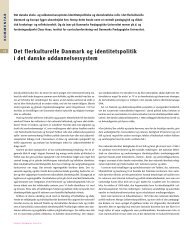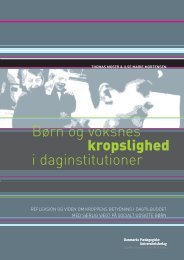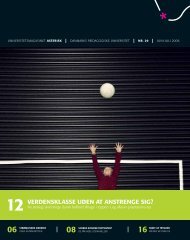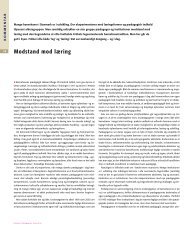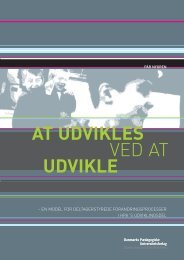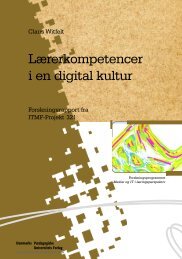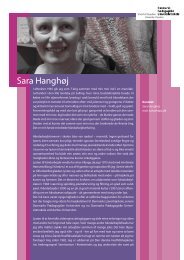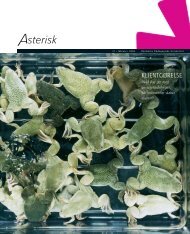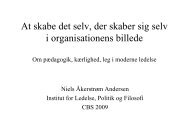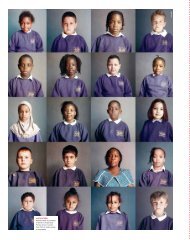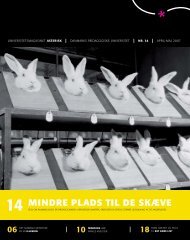SRI-Teknisk rapport-sen.v13 - DPU
SRI-Teknisk rapport-sen.v13 - DPU
SRI-Teknisk rapport-sen.v13 - DPU
You also want an ePaper? Increase the reach of your titles
YUMPU automatically turns print PDFs into web optimized ePapers that Google loves.
Jones, G. W. J. B. R. C. L. Y. T. D. M. (1999). The Impact of High Stakes Testing on Teachers and Students<br />
in North Carolina. Phi, Delta, Kappan, 81(3), 199-204.<br />
Kozulin, A., & Garb, E. (2004). Dynamic Assessment of Literacy: English as a Third Language. European<br />
Journal of Psychology of Education, 19(1), 65-77.<br />
Lane, S., Parke, C. S., & Stone, C. A. (2002). The Impact of a State Performance-Based Assessment and<br />
Accountability Program on Mathematics Instruction and Student Learning: Evidence From Survey<br />
Data and School Performance. Educational Assessment, 8(4), 279-315.<br />
Le Floch, K. C., & et al. (2007). State and local implementation of the no child left behind act vol 3.<br />
Washington: U.S. Department of Education.<br />
Luxia, Q. (2004). Has a High-Stakes Test Produced the Intended Changes? In L. W. Cheng, Y.; Curtis, A.<br />
(Ed.), Washback in language testing: Research contexts and methods (pp. 171-190). Mahwah, NJ:<br />
US: Lawrence Erlbaum Associates Publishers.<br />
Luxia, Q. (2005). Stakeholders' Conflicting Aims Undermine the Washback Function of a High-Stakes Test.<br />
Language Testing, 22(2), 142-173.<br />
Luxia, Q. (2007). Is testing an efficient agent for pedagogical change? Examining the intended washback of<br />
the writing task in a high-stakes English test in China. Assessment in Education, 14(1), 51-74.<br />
Madelaine, A., & Wheldall, K. (2004). Teachers' reactions to curriculum-based passage reading test data.<br />
Special Education Perspectives, 13(1), 55-65.<br />
Malcolm, H. C., Byrne, M., & Harlen, W. (1995). Teachers' assessment and national testing in primary<br />
schools in Scotland: roles and relationships. Assessment in Education, 2(2), p129-144.<br />
Mason, R. (2005). The effect of formal assessment on secondary school art and design education. London:<br />
EPPI.<br />
Mattsson, H. (1989). Proven i skolan sedda genom lärarnas ögon. Umeå: Pedagogiska inst., Umeå<br />
Universitet.<br />
Mildner, T. (1989). A Statewide Assessment and Evaluation of Fourth Grade Mathematics Delivery System.<br />
not found(not found), ort.<br />
Parke, C. S., Lane, S., & Stone, C. A. (2006). Impact of a State Performance Assessment Program in Reading<br />
and Writing. Educational Research and Evaluation, 12(3), 239-269.<br />
Parker, D. L., & Picard, A. J. (1997). Portraits of Susie: Matching Curriculum, Instruction, and Assessment.<br />
Teaching Children Mathematics, 3(7), 376-382.<br />
Pinder, P. J. (2008). A Critique Analysis of NCLB, Increase Testing, and Past Maryland Mathematics and<br />
Science HSA Exams: What Are Maryland Practitioners' Perspectives?<br />
Prueher, J. (1987). Improving Achievement and Attitudes in Elementary Algebra through Written Error-<br />
Correcting Feedback and Free Comments on Tests. not found(not found), ort.<br />
Roach, A. T., Elliott, S. N., & Berndt, S. (2007). Teacher perceptions and the consequential validity of an<br />
alternate assessment for students with significant cognitive disabilities. Journal of Disability Policy<br />
Studies, 18(3), 168-175.<br />
Ryan, J., & Williams, J. (2000). National testing and the improvement of classroom teaching: can they<br />
coexist? British Educational Research Journal, 26(1), p49-73.<br />
135



